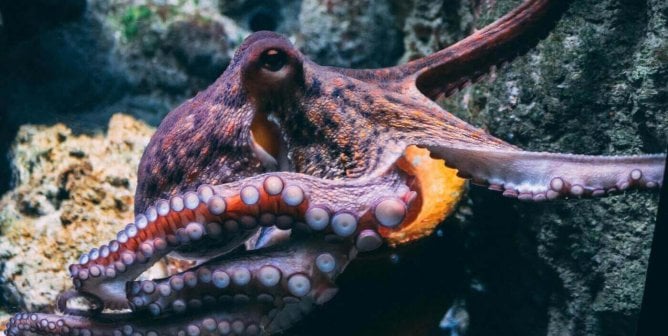Fish Feel Pain
In her book Do Fish Feel Pain?, biologist Victoria Braithwaite says that “there is as much evidence that fish feel pain and suffer as there is for birds and mammals.”
Fish don’t audibly scream when they’re impaled on hooks or grimace when the hooks are ripped from their mouths, but their behavior offers evidence of their suffering—if we’re willing to look. For example, when Braithwaite and her colleagues exposed fish to irritating chemicals, the animals behaved as any of us might: They lost their appetite, their gills beat faster, and they rubbed the affected areas against the side of the tank.
Neurobiologists have long recognized that fish have nervous systems that comprehend and respond to pain. Fish, like “higher vertebrates,” have neurotransmitters such as endorphins that relieve suffering—the only reason for their nervous systems to produce these painkillers is to alleviate pain. Researchers have created a detailed map of more than 20 pain receptors, or “nociceptors,” in fish’s mouths and heads—including those very areas where an angler’s barbed hook would penetrate a fish’s flesh. As Dr. Stephanie Yue wrote in her position paper on fish and pain, “Pain is an evolutionary adaptation that helps individuals survive . . . . [A] trait like pain perception is not likely to suddenly disappear for one particular taxonomic class.”
Even though fish don’t have the same brain structures that humans do—fish do not have a neocortex, for example—Dr. Ian Duncan reminds us that we “have to look at behaviour and physiology,” not just anatomy. “It’s possible for a brain to evolve in different ways,” he says. “That’s what is happening in the fish line. It’s evolved in some other ways in other parts of the brain to receive pain.”
Numerous studies in recent years have demonstrated that fish feel and react to pain. For example, when rainbow trout had painful acetic acid or bee venom injected into their sensitive lips, they stopped eating, rocked back and forth on the tank floor, and rubbed their lips against the tank walls. Fish who were injected with a harmless saline solution didn’t display this abnormal behavior.
Trout are “neophobic,” meaning that they actively avoid new objects. But those who were injected with acetic acid showed little response to a brightly colored Lego tower that was placed in their tank, suggesting that their attention was focused instead on the pain that they were experiencing. In contrast, trout injected with saline—as well as those who were given painkillers following the painful acid injection—displayed the usual degree of caution regarding the new object. Similar results have been demonstrated in human patients suffering from painful medical conditions: Medical professionals have long known that pain interferes with patients’ normal cognitive abilities.
A study in the journal Applied Animal Behaviour Science found that fish who are exposed to painful heat later show signs of fear and wariness—illustrating that fish both experience pain and can remember it.
A study by scientists at Queen’s University Belfast proved that fish learn to avoid pain, just like other animals. Rebecca Dunlop, one of the researchers, said, “This paper shows that pain avoidance in fish doesn’t seem to be a reflex response, rather one that is learned, remembered and is changed according to different circumstances. Therefore, if fish can perceive pain, then angling cannot continue to be considered a non-cruel sport.”
Similarly, researchers at the University of Guelph in Canada concluded that fish feel fear when they’re chased and that their behavior is more than simply a reflex. The “fish are frightened and … they prefer not being frightened,” said Dr. Duncan, who headed the study.
In a 2014 report, the Farm Animal Welfare Committee (FAWC), an advisory body to the British government, stated, “Fish are able to detect and respond to noxious stimuli, and FAWC supports the increasing scientific consensus that they experience pain.”
Dr. Culum Brown of Macquarie University, who reviewed nearly 200 research papers on fish’s cognitive abilities and sensory perceptions, believes that the stress that fish experience when they’re pulled from the water into an environment in which they cannot breathe may even exceed that of a human drowning. “[U]nlike drowning in humans, where we die in about 4–5 minutes because we can’t extract any oxygen from water, fish can go on for much longer. It’s a prolonged slow death most of the time,” he says.
Anglers may not want to think about it, but fishing is nothing more than a cruel blood sport. When fish are impaled on an angler’s hook and yanked out of the water, it’s not a game to them. They are scared, in pain, and fighting for their lives. Michael Stoskopf, professor of aquatics, wildlife, and zoologic medicine and of molecular and environmental toxicology at North Carolina University, said, “It would be an unjustified error to assume that fish do not perceive pain in these situations merely because their responses do not match those traditionally seen in mammals subjected to chronic pain.”
As a result of his research, Dr. Culum Brown concludes that “it would be impossible for fish to survive as the cognitively and behaviorally complex animals they are without a capacity to feel pain” and “the potential amount of cruelty” that we humans inflict on fish “is mind-boggling.”
Please leave fish off your forks. Click here to learn how to go vegan, or order PETA’s free vegan starter kit for great tips and recipes to help you make the transition to fish-free, vegan eating.








